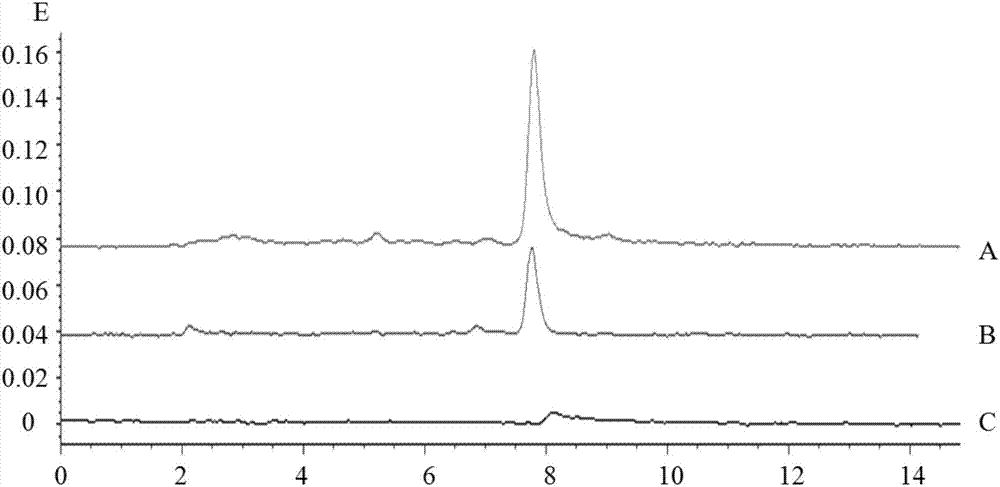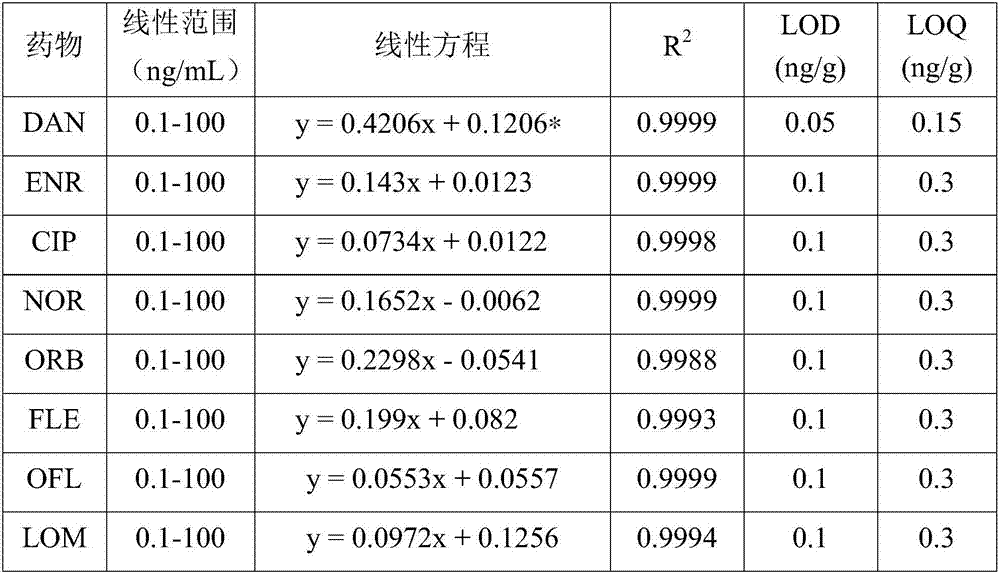Detection method of quinolone medicine residues
A quinolone and detection method technology, which is applied in the detection field of quinolone drug residues, can solve the problems of high consumption of organic solvents, cannot be reused, complicated operations, etc., and achieves low cost, less use of organic solvents, and good repeatability. Effect
- Summary
- Abstract
- Description
- Claims
- Application Information
AI Technical Summary
Problems solved by technology
Method used
Image
Examples
Embodiment 1
[0024]Put the glass beads into a mixed solution (7:3, V / V) of concentrated sulfuric acid with a mass fraction of 98% and hydrogen peroxide with a mass fraction of 30%, heat in an 80°C water bath for 1h, and rinse with ultrapure water and pure ethanol in turn Afterwards, it was placed in ATPES ethanol solution (components by volume, including 5% APTES, 5% deionized water and 90% pure ethanol) to react for 24h, washed with ultrapure water and pure ethanol successively, placed in 80 Under high-purity nitrogen flow overnight, after 15 hours, take out the glass microspheres and activate them with 2.5% glutaraldehyde PBS solution for 5 hours. Shake for 24 hours under the condition of 4 on the shaker, wash with ultrapure water, place in a 0.3M ethanolamine solution with a pH of 7.5 to inactivate unreacted glutaraldehyde, take out the glass beads after 1 hour and put them in 0.2mg / mL of NaCNBH 3 In the solution for 24h, the imide is converted into an amine and the covalent bond is s...
Embodiment 2
[0030] Put the glass beads into a mixed solution (7:3, V / V) of concentrated sulfuric acid with a mass fraction of 98% and hydrogen peroxide with a mass fraction of 30%, heat in an 80°C water bath for 1h, and rinse with ultrapure water and pure ethanol in turn Afterwards, it was placed in ATPES ethanol solution (components by volume, including 5% APTES, 5% deionized water and 90% pure ethanol) to react for 24h, washed with ultrapure water and pure ethanol successively, placed in 80 Under high-purity nitrogen flow overnight, after 15 hours, take out the glass microspheres and activate them with 2.5% glutaraldehyde PBS solution for 5 hours. Shake for 24 hours under the condition of 4 on the shaker, wash with ultrapure water, place in a 0.3M ethanolamine solution with a pH of 7.5 to inactivate unreacted glutaraldehyde, take out the glass beads after 1 hour and put them in 0.2mg / mL of NaCNBH 3 In the solution for 24h, the imide is converted into an amine and the covalent bond is ...
Embodiment 3
[0036] Put the glass beads into a mixed solution (7:3, V / V) of concentrated sulfuric acid with a mass fraction of 98% and hydrogen peroxide with a mass fraction of 30%, heat in an 80°C water bath for 1h, and rinse with ultrapure water and pure ethanol in turn Afterwards, it was placed in ATPES ethanol solution (components by volume, including 5% APTES, 5% deionized water and 90% pure ethanol) to react for 24h, washed with ultrapure water and pure ethanol successively, placed in 80 Under high-purity nitrogen flow overnight, after 15 hours, take out the glass microspheres and activate them with 2.5% glutaraldehyde PBS solution for 5 hours. Shake for 24 hours under the condition of 4 on the shaker, wash with ultrapure water, place in a 0.3M ethanolamine solution with a pH of 7.5 to inactivate unreacted glutaraldehyde, take out the glass beads after 1 hour and put them in 0.2mg / mL of NaCNBH 3 In the solution for 24h, the imide is converted into an amine and the covalent bond is ...
PUM
| Property | Measurement | Unit |
|---|---|---|
| concentration | aaaaa | aaaaa |
Abstract
Description
Claims
Application Information
 Login to View More
Login to View More - R&D
- Intellectual Property
- Life Sciences
- Materials
- Tech Scout
- Unparalleled Data Quality
- Higher Quality Content
- 60% Fewer Hallucinations
Browse by: Latest US Patents, China's latest patents, Technical Efficacy Thesaurus, Application Domain, Technology Topic, Popular Technical Reports.
© 2025 PatSnap. All rights reserved.Legal|Privacy policy|Modern Slavery Act Transparency Statement|Sitemap|About US| Contact US: help@patsnap.com



